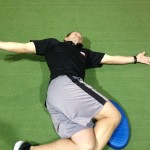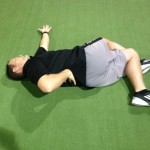Brian Schiff’s Blog
Injury Prevention, Sports Rehab & Performance Training Expert
I work with a lot of baseball players in my clinic. In many cases, I see similar issues and recurring problems in them, especially pitchers. Some of these issues include:
- Scapular dyskinesia
- Limited thoracic spine mobility (extension and/or rotation)
- Soft tissue tightness (lats, post shoulder, pec major/minor)
- Poor muscular strength/endurance in the rotator cuff and scapular stabilizers
- Glenohumeral internal rotation deficit (GIRD)
I integrate routine mobility exercises for my throwers, as well as other overhead athletes (tennis, swimming, volleyball, etc) to better prepare them for training and their sport, as well as prevent poor mechanics and compensatory motion that may lead to aberrant stress on the rotator cuff and labrum.
The following video reveals five of my preferred exercises using a foam roller to improve thoracic spine mobility, decrease latissimus tightness, and stretch the pec major/minor while facilitating lower trapezius activation.
In order you will see:
- Lat rolling
- T-spine extension in supine
- T-spine extension coupled with lat stretch
- T-spine rotation
- Retraction and downward rotation
I advise performing 5-10 repetitions of each prior to training and sport. These will help improve performance, optimize overhead mechanics and reduce injury risk associated with overhead sports.
There are several things that contribute to shoulder impingement and rotator cuff pain. Perhaps one of the biggest issues that impacts overhead athletes, Crossfit enthusiasts and the avid weight lifter is limited shoulder mobility. Poor flexibility in the pecs, lats, posterior shoulder as well as limited thoracic spine extension and rotation all contribute to suboptimal movement.
Poor mobility can place the scapula in biomechanically flawed positions, increase glenohumeral internal rotation and restrict shoulder movement at end range creating compensatory movement and pain. The video below is a snippet from my upcoming webinar on rotator cuff dysfunction and nonoperative treatment.
This webinar will be great for strength coaches, exercise enthusiasts, Crossfit athletes/coaches, athletic trainers and physical therapists. If you want to attend the webinar or catch the on-demand version, simply visit www.alliedhealthed.com. In addition, you may find my DVD on rotator cuff training very helpful in overcoming shoulder pain and staying pain free in the gym.
Click here to see a brief video overview of the DVD or visit my site at www.BrianSchiff.com for more info. Use the code Holiday15 at checkout from today until December 25 to save $10 off the retail price.
Have a great Thanksgiving and enjoy your time with family and friends!
The shoulder mobility screen in the FMS often reveals side-to-side asymmetries. It is more common to see hypermobility in female clientele, while their male counterparts exhibit more hypomobility. Overhead athletes tend to demonstrate excessive horizontal external rotation and a relative loss of internal rotation on the dominant side. This hypomobility can be detrimental to overhead athletes and increase risk for overuse injuries if it becomes excessive.
The following exercise is an effective way to improve shoulder mobility and optimize function. One important point is to focus on form and move very deliberately through the motion.
Execution: Begin lying on the floor face up. Bend the left knee up to 90 degrees and cross the right leg over top of the left interlocking them. Roll to the left side and pin a folded towel or pad between the right knee and the floor. Place the arms in 90 degrees of shoulder flexion with the right on top of the left in an outstretched position. Next, slowly sweep the right arm up overhead and around the body as you attempt to place the torso/back on the floor. The finish position for the right arm will be reaching the right hand and arm up behind the back.
Exhale as you perform the sweeping motion and hold the end position for 2 seconds. Reverse direction and return to the start position. Perform 5-10 repetitions on each side.
Application: Limited shoulder mobility is a common finding, especially among male clientele with tightness in the pecs, lats and posterior shoulder. Asymmetry with respect to mobility is common with greater difficulty found trying to reach the dominant arm up behind the back on the FMS shoulder mobility screen. This exercise will help improve thoracic spine motion and shoulder mobility. The focus should be on strict form and proper stabilization to avoid unwanted motion. Pinning the pad (or towel roll) to the floor will help ensure better stabilization.
If hypomibility is an issue and clients score a 1, foam rolling the pec minor/major, latissimus dorsi and the posterior rotator cuff musculature prior to performing the exercise will be helpful. Stability training can be added in later once the soft tissue mobility restrictions and movement pattern is improving.
Working with athletes of many disciplines affords me an opportunity to look at many shoulders week to week. Increasingly, I am seeing more Crossfit athletes for various shoulder problems. In many cases, they have rotator cuff tendonitis, impingement, AC joint pain, labral pathology or a combination of the aforementioned issues. The other big group of athletes I see is throwers.
These two groups share many of the same dysfunctions including posterior shoulder tightness and decreased mobility. Tightness in the pecs and lats is commonplace. I feel latissimus tightness often goes unnoticed or perhaps is not an area of emphasis in prehab/rehab plans. Tight lats will restrict elevation and contribute to postural dysfunction.
With restricted elevation, athletes may turn to excessive spinal extension and/or rotation to achieve elevation necessary (e.g. overhead squats, snatches, throwing) and this can contribute to poor movement patterns. I have also seen this impact volleyball players asymmetrically with serving and hitting.
Lat tightness can easily be assessed by placing the athlete supine and simply asking them to bring the arms completely overhead. While most people do not have 180 degrees of flexion, I feel working to achieve elevation greater than or equal to 160 is completely reasonable. The body often uses abduction and external rotation to make things work (and this is natural for throwers), but the more pure elevation capacity we have the the better.
Crossfit involves lots of pull-ups and throwing heavily utilizes the pecs and lats for acceleration. It only follows that muscular tightness in this region may need to be addressed. Step one often involves soft tissue mobilization/compression techniques. I prefer to use a Trigger Point ball or Grid to work on the soft tissue mobilizing it on the wall (TP ball) or floor (Grid) in an elevated position.
Next, I like to employ active mobility work. I recently featured a simple exercise using the BOSU Ballast Ball in my PFP column. The pictures below reveal a rolling double arm version, as well as a single arm method/progression. These active movements can also be complimented by sustained holds as desired.
For a more detailed description and application of this exercise, click here to read my “Functionally Fit” column. I had one Crossfit enthusiast see me for limited shoulder mobility as it was hindering his overhead lifts and causing back pain. He had about 130 degrees of shoulder flexion. Daily STM using the foam roller, mobility work and some stretching increased his elevation by 10 degrees in 2-3 short weeks.
So, the take home message is that overhead athletes should assess and address this limitation if it is present as it may cause kinetic chain issues and energy leaks. Improving mobility will better enable utilization of proper muscle activation and optimal movement patterns.








